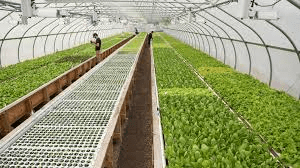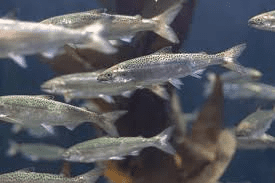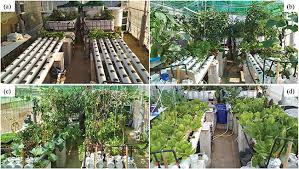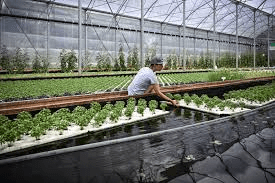Aquaponics farming is a sustainable method of food production that combines aquaculture (raising fish) and hydroponics (growing plants without soil) into a single, integrated system.
In this method, the waste produced by the fish supplies nutrients for the plants, while the plants naturally filter and clean the water, which is then recirculated back to the fish tank. This creates a self-sustaining cycle that minimizes waste and maximizes resource use.
Aquaponics farming is gaining popularity due to its ability to produce fresh vegetables and fish in a controlled environment, making it suitable for both small-scale and commercial farming.
How Aquaponics Works
Aquaponics works by using the natural relationship between fish, plants, and bacteria. Here’s a simple explanation of how it functions:
1. Fish produce waste: In an aquaponics system, fish excrete waste into the water. This waste is high in ammonia, which is toxic to fish if it builds up. However, it’s an essential nutrient for plants.
2. Bacteria convert waste: Beneficial bacteria in the system break down the fish waste, turning ammonia into nitrites, and then into nitrates. Nitrates are a form of nitrogen that plants can easily absorb.
3. Plants absorb nutrients: The plants absorb the nitrates, cleaning the water as they grow. They also use other nutrients from the fish waste, helping them to thrive without the need for chemical fertilizers.
4. Clean water returns to the fish: After the plants have absorbed the nutrients, the clean water is recirculated back into the fish tank, creating a continuous loop.
This closed-loop system mimics natural ecosystems and ensures that both plants and fish can thrive without the need for chemical additives or artificial fertilizers.
Benefits of Aquaponics Farming

Aquaponics farming offers several benefits, making it an attractive option for sustainable farming:
1. Efficient use of resources: Aquaponics requires up to 90% less water than traditional soil farming because water is recirculated. This makes it ideal for areas with limited water resources.
2. No need for chemical fertilizers: Since the fish waste provides all the nutrients needed for plant growth, there’s no need to use synthetic fertilizers, reducing environmental pollution.
3. Faster plant growth: Plants in aquaponics systems tend to grow faster than in traditional farming, as they have constant access to nutrients and water.
4. Year-round production: Aquaponics systems can be set up indoors or in greenhouses, allowing for year-round production regardless of weather conditions.
5. Dual harvest: Farmers can harvest both fish and plants, providing a source of protein and vegetables from the same system, increasing productivity.
6. Reduced environmental impact: With no soil erosion, minimal water waste, and fewer chemicals, aquaponics is a more environmentally friendly method of farming compared to conventional agriculture.
Key Components of an Aquaponics System
There are several key components that make up an aquaponics system:
1. Fish Tank: The fish tank is where the fish are raised. The size of the tank depends on the scale of the system and the type of fish being raised. The water in the fish tank is continuously circulated to provide oxygen and remove waste.
2. Grow Beds: Grow beds are where the plants grow. These beds are filled with a growing medium such as clay pebbles or gravel, which supports the plants and helps filter the water. The grow beds also house the beneficial bacteria that convert fish waste into nutrients.
3. Water Pump: A water pump is used to circulate water between the fish tank and the grow beds. This ensures that the plants receive a steady supply of nutrient-rich water and that the fish tank remains clean.
4. Biofilter: The biofilter is where the beneficial bacteria live. It’s responsible for breaking down ammonia into nitrates, making the nutrients available for the plants.
5. Aeration System: Aerators or air pumps are used to oxygenate the water, ensuring that the fish and plants get enough oxygen to survive and thrive.
6. Sump Tank (optional): In larger aquaponics systems, a sump tank is used to collect and recirculate water throughout the system, keeping the water levels consistent.
Types of Aquaponics Systems
There are three main types of aquaponics systems, each with its own advantages and best use cases:
1. Media Bed System: In this system, plants are grown in a bed filled with a growing medium such as gravel or clay pellets. The water from the fish tank flows through the media bed, where it is filtered and cleaned by the plants and the growing medium. This system is simple and ideal for beginners, as it mimics natural soil growing conditions.
2. Nutrient Film Technique (NFT): In an NFT system, plants are grown in channels where a thin film of nutrient-rich water flows over the roots. This system works well for leafy greens and herbs but is not suitable for larger, fruiting plants. It’s efficient in terms of water and space, making it a popular choice for commercial growers.
3. Deep Water Culture (DWC): In a DWC system, plants are grown on floating rafts with their roots suspended directly in the water. The water is circulated and oxygenated, providing constant access to nutrients. DWC is commonly used for growing leafy greens and is known for its high yields.
Read Also: The Health Benefits of Using Dukkah Seasoning on your Cooking
Choosing Fish for Aquaponics

Choosing the right fish for your aquaponics system is crucial for its success. Here are some popular fish species used in aquaponics:
1. Tilapia: Tilapia is one of the most commonly used fish in aquaponics because it’s hardy, grows quickly, and thrives in a wide range of water conditions. It’s also a popular choice for food production.
2. Catfish: Catfish are another popular option because they can tolerate low oxygen levels and are easy to care for. They grow quickly and are well-suited for warm climates.
3. Trout: Trout are ideal for colder climates as they thrive in cooler water. However, they require higher oxygen levels and more attention to water quality.
4. Koi: Koi are ornamental fish often used in decorative aquaponics systems. While not typically used for food, they’re easy to care for and add visual appeal to the system.
5. Goldfish: Like koi, goldfish are used in ornamental systems. They’re hardy and easy to care for, making them a good choice for beginners.
Selecting Plants for Aquaponics
When selecting plants for your aquaponics system, consider the nutrient needs of the plants and the size of your system. Some popular plants for aquaponics include:
1. Leafy Greens: Lettuce, spinach, kale, and other leafy greens are ideal for aquaponics because they grow quickly and require fewer nutrients compared to fruiting plants.
2. Herbs: Basil, mint, parsley, and cilantro are commonly grown in aquaponics systems due to their fast growth and low nutrient requirements.
3. Tomatoes: Tomatoes are fruiting plants that require more nutrients, making them suitable for larger systems with established fish populations.
4. Cucumbers: Cucumbers are another fruiting plant that does well in aquaponics but requires more space and nutrients.
5. Peppers: Like tomatoes, peppers thrive in nutrient-rich environments and are a popular choice for larger aquaponics systems.
6. Strawberries: Strawberries can be grown in aquaponics systems, especially in NFT setups. They require a bit more attention but can yield sweet, delicious fruit.
Water Quality Parameters
To maintain good water quality, several key parameters need to be regularly monitored:
1. pH Levels: The ideal pH for aquaponics is between 6.8 and 7.0, as this range works well for both fish and plants. A pH that is too high or too low can harm the fish and prevent plants from absorbing nutrients.
2. Ammonia Levels: Ammonia is produced by fish waste and needs to be converted into nitrates by beneficial bacteria. High ammonia levels are toxic to fish, so the system must maintain low levels (below 1 ppm).
3. Nitrite and Nitrate Levels: Nitrites should be kept low as they can also harm fish, while nitrates are needed for plant growth. Nitrate levels between 20-40 ppm are ideal for healthy plants.
4. Dissolved Oxygen: Fish need adequate oxygen in the water. Using aeration devices like air pumps ensures that both fish and plants get enough oxygen to thrive.
5. Water Temperature: Different fish and plants require specific water temperatures. Most plants thrive between 18-30°C (65-86°F), and fish like tilapia prefer warmer water (25-30°C).
Read Also: 10 Medicinal Health Benefits Of Convolvulus prostratus (Bindweed)
Nutrient Management in Aquaponics

The fish waste provides most of the nutrients for plant growth, but you might need to supplement specific nutrients, especially in a developing system. Here’s how nutrient management works:
1. Nitrate Management: Fish waste is converted to nitrates, a crucial nutrient for plant growth. A well-established bacterial colony ensures an efficient nitrogen cycle.
2. Trace Elements: Nutrients like iron, calcium, and potassium might need to be added if your plants show deficiencies. This can be done using organic supplements that won’t harm the fish.
3. Regular Testing: Regularly test your water for nutrient imbalances and make necessary adjustments. Keeping a record of your readings helps you monitor trends and prevent problems before they arise.
Common Challenges in Aquaponics Farming
Aquaponics farming is relatively straightforward, but there are common challenges that beginners may face:
1. pH Fluctuations: Maintaining a balanced pH can be challenging, as both fish waste and plants affect it. Use pH adjusters (organic, if possible) to keep the pH stable.
2. Fish Health Issues: Fish diseases can spread quickly in a closed system. Ensure proper water quality, avoid overcrowding, and remove sick fish immediately.
3. Nutrient Deficiencies: Some plants might show signs of nutrient deficiencies, particularly in newer systems. Monitor nutrient levels and supplement trace minerals like iron and calcium as needed.
4. Overfeeding Fish: Overfeeding leads to excess waste, causing water quality issues. Feed fish only what they can consume within a few minutes to prevent waste accumulation.
5. Pests and Diseases in Plants: While aquaponics systems are less prone to pests, diseases can still affect plants. Use natural pest control methods, such as introducing beneficial insects or using organic sprays.
Harvesting Fish and Plants
Harvesting fish and plants is one of the most rewarding parts of aquaponics farming. Here’s a simple guide on how to do it:
1. Harvesting Fish: Fish are ready for harvest when they reach their mature size. Use a net to gently remove fish from the tank. Ensure the water temperature remains stable during harvesting to avoid stressing other fish. Once harvested, the fish can be prepared for consumption or sold, depending on your goals.
2. Harvesting Plants: Harvest plants once they reach maturity. Leafy greens can be harvested by cutting the outer leaves and allowing the inner ones to continue growing. For fruiting plants, harvest once the fruit has fully developed. Be careful not to damage the plant during harvesting.
3. Post-Harvest Handling: After harvesting, clean the grow beds, remove plant debris, and prepare for the next planting cycle. Check for any imbalances in nutrients after harvesting and adjust as needed.
Tips for Scaling Your Aquaponics System
As your experience with aquaponics grows, you might want to scale up your system. Here are some tips for expanding your system:
1. Increase Tank Size: A larger fish tank can support more fish, allowing for higher nutrient production and more plant growth. Gradually increase the size of your system to avoid overloading it.
2. Add More Grow Beds: As the fish population increases, adding more grow beds will help manage the nutrient levels and give you more space for crops.
3. Improve Technology: Invest in better water pumps, aerators, and sensors to maintain the system more effectively as it grows.
4. Automate Monitoring: Automation systems for monitoring pH, water temperature, and nutrient levels can make managing a larger system easier. Automation saves time and ensures the system remains balanced.
5. Diversify Crops and Fish: Introduce new species of plants and fish to diversify your yield. Ensure that new species are compatible with your existing system.
6. Join Aquaponics Communities: Learn from other aquaponics farmers by joining online forums, attending workshops, or networking with local farmers. Sharing knowledge will help you overcome challenges and grow your system successfully.
Aquaponics farming is a sustainable and efficient way to grow both fish and plants in a symbiotic environment. By understanding how aquaponics works, selecting the right components, and choosing suitable fish and plants, you can create a thriving system that provides fresh produce and protein.
Whether you’re a beginner or an experienced farmer, aquaponics offers a rewarding and environmentally friendly method of food production. By following these guidelines, you can set up and maintain a successful aquaponics farm that benefits both you and the environment.
Do you have any questions, suggestions, or contributions? If so, please feel free to use the comment box below to share your thoughts. We also encourage you to kindly share this information with others who might benefit from it. Since we can’t reach everyone at once, we truly appreciate your help in spreading the word. Thank you so much for your support and for sharing!
Read Also: How to Make an Avocado Tree Bear Fruit
Frequently Asked Questions
We will update this section soon.

